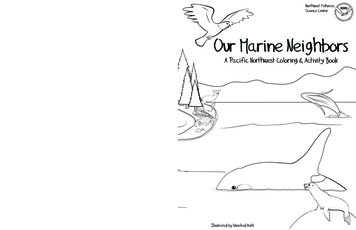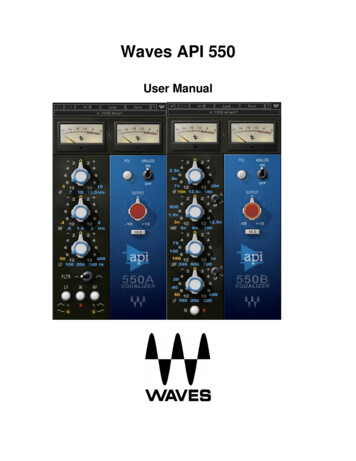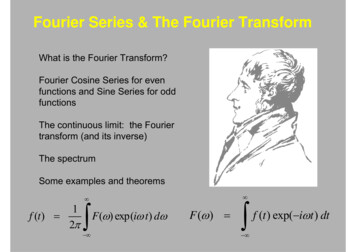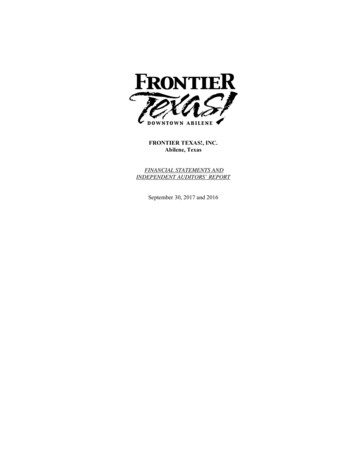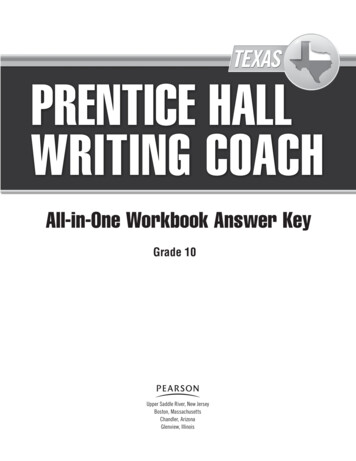
Transcription
Ocean Waves121
A Little MathlWave speed wave length/wave periodlC L/T3Relationship of Wave Length toDepth of Wave Motion42
Motion of Water as Wave PassesWater in the crest of the wave move in the samedirection as the wave, but water in the trough move inthe opposite direction.5Classifying WavesWaves are classified on the basis of:lDisturbing forcelFree waves vs. forced waveslRestoring forcelWavelength63
Classifying Waves7Types of WavesWaves transmit energy across the ocean’s surface.84
Wind WavesWind waves are gravity waves formed by the transfer ofwind energy into water. Wind forces convert capillarywaves to wind waves.9Factors Affecting Wind WaveDevelopmentWind strength - wind must be moving faster than the wavecrests for energy transfer to continueWind duration - winds that blow for a short time will notgenerate large wavesFetch - the uninterrupted distance over which the windblows without changing direction105
Factors Affecting Wind WaveDevelopment11Relationshipbetweenwave heightand waveenergy126
Wave DispersionThe longer the wave length, the faster thewave speed.13Swell Formation and DispersionWave separation, ordispersion, is a function ofwavelength. Waves with thelongest wavelength move thefastest and leave the area ofwave formation sooner. Thesmooth undulation of oceanwater caused by wavedispersion is called swell.A wave train.147
Interference And Rogue WavesWhen waves from different directions meet, theyinterfere with one another.Wave interference can be:Destructive interference – two waves that cancel each other out,resulting in reduced or no waveConstructive interference – additive interference that results inwaves larger than the original wavesRogue waves - freak waves that occur due to interference andresult in a wave crest higher than the theoretical maximum15Wave Interference168
Wave Interference17Waves Entering Shallow Water189
Shallow-Water WavesWhen waves enter shallow water:Wave speed decreasesWave length decreasesWave period does not changeWave height increases19Wind Waves ApproachingShoreWhat happens when wind waves break againstthe shore?2010
Wave SteepnessMaximum height for a given wavelength is basedon H/L. If H/L 1/7, wave becomes too steep.21Breaking WavesPlunging waves break violently against the shore, leaving an air-filledtube, or channel, between the crest and foot of the wave. Plungingwaves are formed when waves approach a shore over a steeply slopedbottom.Spilling waves occur on gradually sloping ocean bottoms. The crest ofa spilling wave slides down the face of the wave as it breaks on shore.2211
Wave Refraction, Diffraction,and ReflectionWave refraction - the slowing and bending of waves inshallow waterWave diffraction - propagation of a wave around anobstacleWave reflection - occurs when waves “bounce back” froman obstacle they encounter. Reflected waves can causeinterference with oncoming waves, creating standingwaves23Wave Refraction2412
Wave Refraction252613
Wave Diffraction272814
Internal WavesWaves that occur at the boundaries of water layerswith different densities are called internal waves.29Standing Waves or Seiches3015
313216
33Sumatra-Andaman IslandEarthquakellllllMagnitude 9.0Sunday, Dec. 26, at 7:58 a.m. local time30 km off the west coast of northernSumatra250 km SSE of Banda AcehFourth largest in the world since 1964Prince William Sound, Alaska, quakeMore casualties than any other tsunami inrecorded history3417
353618
373819
394020
41Tsunami Warning Network4221
Key IdeaslWaves transmit energy, not water mass, across the ocean’ssurface.lThe behavior of a wave depends on the relation between thewave’s size and the depth of water through which it is moving.lWind waves form when energy is transferred from wind to water.lWaves can change direction by refraction and diffraction, caninterfere with one another, and reflect from solid objects.43SummaryParts of an ocean wave4422
Wind Waves Wind waves are gravity waves formed by the transfer of wind energy into water. Wind forces convert capillary waves to wind waves. 10 Wind strength - wind must be moving faster than the wave crests for energy transfer to continue Wind duration - winds


